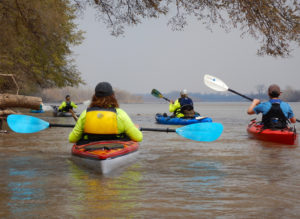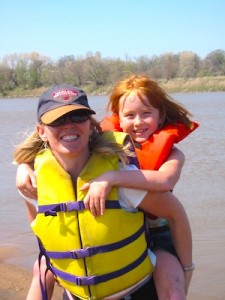|
We recommend that beginner paddlers enjoy the river when the water flow is below 5000 cubic feet per second (cfs). |
Canoe Safety
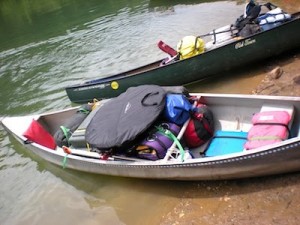 The canoe is one of the oldest means of water travel. These boats have remained virtually unchanged in design for thousands of years. But don’t let a canoe’s simplicity fool you. As easy as it may seem to leisurely paddle a canoe, a journey can quickly become dangerous if appropriate safety guidelines are overlooked.
The canoe is one of the oldest means of water travel. These boats have remained virtually unchanged in design for thousands of years. But don’t let a canoe’s simplicity fool you. As easy as it may seem to leisurely paddle a canoe, a journey can quickly become dangerous if appropriate safety guidelines are overlooked.
You can minimize your risk of danger by being smart about where and when you canoe. Choose a lake or river that is appropriate for your skill level. Try to avoid high water (it makes a river run faster), high winds and storms. And don’t go out alone — there’s safety in numbers. It is recommended that you canoe with a minimum of two boats.
When you are paddling a section of a river for the first time you should find out about currents, obstructions  like dams or weirs and other information that could effect your safety. It is also a good idea to let a family member or a friend know about your trip and when you plan to return home.
like dams or weirs and other information that could effect your safety. It is also a good idea to let a family member or a friend know about your trip and when you plan to return home.
Before you even step into your canoe, make sure it is in good condition and that you take along the following items:
- At least two paddles, plus an extra in case you drop or break one
- Extra ropes or lines
- A bail bucket
- A whistle or air horn to signal distress
- A first-aid kit
- A dry change of clothes in cooler weather
- Plenty of water and food
- A light if you will be out in low-light conditions
- A personal flotation device (life vest), with a whistle attached, for each passenger
- Sun protection – hats, sunscreen, long sleeves and pants
- Map – be sure you know where you are so you do not get lost!
- A cell phone in a waterproof bag.
Even if you are experienced and careful, it is still possible that you may tip. To avoid having a canoe tipping turn into a disaster tie all equipment to your canoe – put your equipment into a waterproof bag to keep it dry and tie it to one of the center beams in the canoe so that you don’t lose everything.
To get into your canoe, have someone hold it steady. As you step in, bend your knees and grab the sides of the canoe for balance. Walk to your seat along the center of the boat. Remember to remain in your seat. The slightest shift of weight can make a canoe tip. It is important to keep your load balanced. Avoid sudden movements or rocking from side to side.
Once you are paddling wearing a PFD is an absolute must, particularly considering how unstable a canoe is and the risk of drowning and hypothermia. Keep your shoes on to avoid slipping or stepping on sharp objects near shore.
- Keep an eye out for other boat traffic and keep appropriate distance
- Heed all safety warnings
- Try to keep your canoe at right angles to big waves
- Look out for hazards such as low branches, fallen trees, rocks and debris
- Be aware of the currents in the water – you don’t want to end up floating farther downstream than you planned
- Always sit on the seats or in the center of the canoe – sitting on the side of a canoe will cause it to tip over
- Do not canoe in bad weather or high water
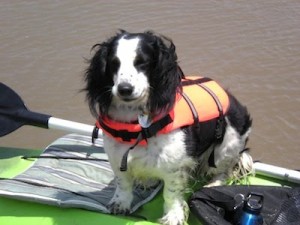 If your canoe does tip over, don’t panic. Your canoe will float even if its full of water, and you can wait until you can get to shore to empty it. Stay with your canoe and paddle or push it toward the shore. When you get to shallow water, flip the canoe with the help of another person and carefully climb back in.
If your canoe does tip over, don’t panic. Your canoe will float even if its full of water, and you can wait until you can get to shore to empty it. Stay with your canoe and paddle or push it toward the shore. When you get to shallow water, flip the canoe with the help of another person and carefully climb back in.
The Kaw is a safe river at low water levels for novices and families; however, it is important to stay away from Bowersock dam and the low water notches of the Topeka and I-435 coffer dams because of the “hydraulics” . When water falls straight down, it creates a continuously circulating current that spins backward. Large hydraulics like the ones below low water notches of the dams are called keeper holes because they can keep a person tumbling deep underwater indefinitely. If you should be caught in a hole, tuck your knees to your chest. The river will likely push you down and out of the hole. It is also important to stay away from strainers – stumps or rocks that have caught debris. If your boat is caught sideways to a strainer, LEAN INTO the strainer, usually the river will pull your boat around the strainer but if not you will need another boater to throw you a rope. If you have fallen out of your boat and the river is pulling you toward a strainer, swim aggressively towards the strainer and crawl on top of the strainer.
River Safety Lesson Plan
Teachers, parents and educators can find lesson plans and materials provided in the Kids 4 the Kaw, the River Safety Lesson Plan developed for the Teens 4 the Kaw or High School. We encourage everyone who works with youth to help us make sure that everyone has a safe and fun time at the river.
Personal Safety on the River
Who should wear a Personnel Flotation Device? Everyone.
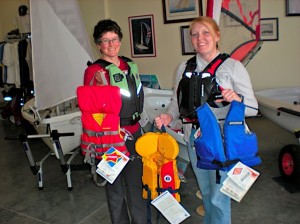 Cardinal Rules of PFDs
Cardinal Rules of PFDs
2. Make sure your PFD fits.
3. Don’t sit on your PFD–take care of it, it could save your life.
4. Wear your PFD!
Testing your PFD
1. Put the PFD around your neck
2. Tie the neck straps in a bow
3. Buckle the waist belt
4. Pull the waist belt until it is snug (ideally, the PFD should be adjustable so that you can get a snug, but comfortable fit, over a range of clothing, from a T-shirt to a pile sweater to a parka or rain-coat).
5. Try some paddling motions to make sure the PFD doesn’t chafe or impair your range of motion.
6. Kneel or sit, and with your arms raised over your head, ask a friend to lift the top of PFD as high as it will go. If the neck tie of the PFD goes above your chin, or if your ears and neck slip though the head opening, it’s too loose. The PFD should not move freely or slip off.
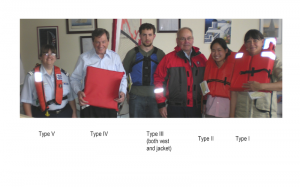
The United States Coast Guard approves different types of Personal Floatation Devices (PFDs) for different activities—check the label on your PFD to make sure it is approved for what you are planning to do with it. Also make sure the PFD is the right size for the person who will be using it (they are rated by weight), and if it is for a child make sure you use a PFD that is specially designed for children.
Type I: Off shore life jackets provide the most buoyancy. These are very thick and will keep you face-up when unconscious for long periods of time. They are used in lare lakes (like Lake Superior) and the ocean.
Type II: Near shore life jackets are used by boaters on lakes like Clinton and rivers like the Kaw where you can expect a fairly quick rescue. They will float you face up if you are unconcious. They are the one you typically see in use in Kansas.
Type III: Floatation Aids are vests or jackets that are designed for active sports like fishing or kayaking on inland waters like Clinton Lake or the Kaw. They are worn all the time and are designed to be comfortable and to move easily when you are paddling. They are not designed to float you face up if you are unconscious or in rough water.
Type IV: Throwable Floatation Devices can be a circular ring or a cushion and are not meant to be worn; they are thrown to people in the water to help them stay afloat during a rescue.
Type V: Special Use or Hybrid Devices. These are for specific activities and may do things like provide protection from hypothermia in cold water. The Type V PFD shown in the photo is inflatable, and will automatically inflate when it gets wet. Types I-III also come in inflatable models—inflatable vests should not be used for activities that could result in high speeds and the possibility of a high impact since they can be damaged and may not inflate fast enough to save an unconscious person. Inflatable PFDs should also not be worn by children.
River Safety Lesson Plan
Teachers, educators and parents can incorporate lessons on river safety using the lesson plans and materials provided in the Kids 4 the Kaw, the River Safety Lesson Plan developed for the Teens 4 the Kaw or High School. We encourage everyone who works with youth to help us make sure that we all have a safe and fun time at the river.
